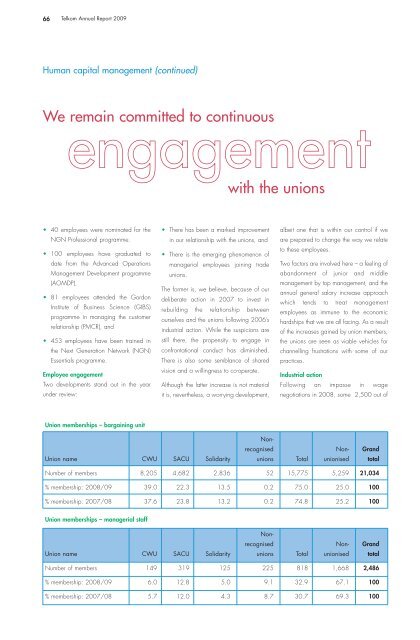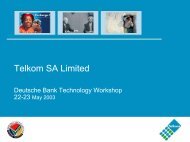Telkom AR front.qxp
Telkom AR front.qxp
Telkom AR front.qxp
Create successful ePaper yourself
Turn your PDF publications into a flip-book with our unique Google optimized e-Paper software.
66<br />
<strong>Telkom</strong> Annual Report 2009<br />
Human capital management (continued)<br />
We remain committed to continuous<br />
engagement<br />
• 40 employees were nominated for the<br />
NGN Professional programme.<br />
• 100 employees have graduated to<br />
date from the Advanced Operations<br />
Management Development programme<br />
(AOMDP).<br />
• 81 employees attended the Gordon<br />
Institute of Business Science (GIBS)<br />
programme in managing the customer<br />
relationship (PMCR), and<br />
• 453 employees have been trained in<br />
the Next Generation Network (NGN)<br />
Essentials programme.<br />
Employee engagement<br />
Two developments stand out in the year<br />
under review:<br />
Union memberships – bargaining unit<br />
• There has been a marked improvement<br />
in our relationship with the unions, and<br />
• There is the emerging phenomenon of<br />
managerial employees joining trade<br />
unions.<br />
The former is, we believe, because of our<br />
deliberate action in 2007 to invest in<br />
rebuilding the relationship between<br />
ourselves and the unions following 2006’s<br />
industrial action. While the suspicions are<br />
still there, the propensity to engage in<br />
con<strong>front</strong>ational conduct has diminished.<br />
There is also some semblance of shared<br />
vision and a willingness to co-operate.<br />
Although the latter increase is not material<br />
it is, nevertheless, a worrying development,<br />
albeit one that is within our control if we<br />
are prepared to change the way we relate<br />
to these employees.<br />
Two factors are involved here – a feeling of<br />
abandonment of junior and middle<br />
management by top management, and the<br />
annual general salary increase approach<br />
which tends to treat management<br />
employees as immune to the economic<br />
hardships that we are all facing. As a result<br />
of the increases gained by union members,<br />
the unions are seen as viable vehicles for<br />
channelling frustrations with some of our<br />
practices.<br />
Industrial action<br />
Following an impasse in wage<br />
negotiations in 2008, some 2,500 out of<br />
Nonrecognised<br />
Non- Grand<br />
Union name CWU SACU Solidarity unions Total unionised total<br />
Number of members 8,205 4,682 2,836 52 15,775 5,259 21,034<br />
% membership: 2008/09 39.0 22.3 13.5 0.2 75.0 25.0 100<br />
% membership: 2007/08 37.6 23.8 13.2 0.2 74.8 25.2 100<br />
Union memberships – managerial staff<br />
with the unions<br />
Nonrecognised<br />
Non- Grand<br />
Union name CWU SACU Solidarity unions Total unionised total<br />
Number of members 149 319 125 225 818 1,668 2,486<br />
% membership: 2008/09 6.0 12.8 5.0 9.1 32.9 67.1 100<br />
% membership: 2007/08 5.7 12.0 4.3 8.7 30.7 69.3 100




